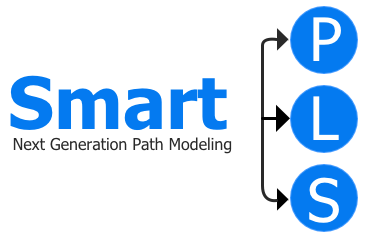Path Analysis and PROCESS
Abstract
PROCESS models in SmartPLS support path analysis and PROCESS. Path analysis is a regression-based technique for estimating models with multiple dependent and independent variables. Unlike PLS-SEM, it is a one-step approach utilizing equally weighted indicators in case of multiple measurements per construct and operates on unstandardized data. It mimics the results from the PROCCESS macro in SPSS.
This algorithm is in beta stage. Changes and additions are likely and feedback is welcome.
Brief description
Path analysis (McDonald, 1996; Wright, 1921) is used to estimate a system of equations where all variables are observed. Unlike regression models, path models can include multiple dependent variables (system of regression models). In SmartPLS, the variables of a path model can be included as single-item constructs. When a variable is based on multiple indicators, they are assigned the same weights to obtain the construct scores. In principle, only the structural relationships between the observed variables (or equally weighted constructs) with or without control variables are modeled. This type of model is often used when one or more variables are to mediate the relationship between two other variables (mediation models). At the same time, moderated mediations can be modeled.
Bootstrapping in SmartPLS enables significance testing for the path model. Thus, the PROCESS module provides all modeling and calculation options that are classically offered for PROCESS (Hayes, 2018). The PROCESS models are automatically generated by SmartPLS and the results are output directly, so that no more calculations outside of SmartPLS are required (Sarstedt et al. 2020). The following figure shows a PROCESS model example in SmartPLS.

PROCESS settings in SmartPLS
Data metric
The option defines whether and how the input data should be transformed. Unstandardized leaves the data as it is. Mean-centered subtracts the mean from the variable (which might be useful to interpret interactions). Standardized subtracts the mean and divides by the standard deviation of the variable; the resulting variables have zero mean and standard deviation of one.
Control variables
Check this box if your path model contains control variables.
Why beta?
SmartPLS has released the PROCESS models option for creating and calculating path models and computing PROCESS results as beta version for the following reasons:
- The current implementation should produce correct results and has undergone some basic testing, but extensive testing is not yet completed.
- The current implementation is not yet finished and will include additional results and outputs in the future.
- Considerable changes are possible in the design and implementation of the PROCESS algorithm and in the structure of the results reports in the future.
- In its original form, PROCESS only uses single (observed) variables. When constructs are created out of multiple variables, their composition needs to be done in advance by the user to obtain the data for the constructs (e.g., equally weighted sum scores). In contrast, SmartPLS's PROCESS implementation provides an automatic equal weighting of indicators when a construct has multiple indicators. However, it has to be clarified which sequence of steps is advantageous (e.g., summation of standardized indicators with subsequent standardization of the obtained construct scores or summation of the original data with or without subsequent standardization of the obtained construct scores, etc.).
References
- Hayes, A. F. (2018). Introduction to Mediation, Moderation, and Conditional Process Analysis: A Regression-Based Approach (2 ed.). Guilford Press: New York, NY.
- McDonald, R. P. (1996). Path Analysis with Composite Variables. Multivariate Behavioral Research, 31(2), 239-270.
- Sarstedt, M., Hair, J. F., Nitzl, C., Ringle, C. M., & Howard, M. C. (2020). Beyond a Tandem Analysis of SEM and PROCESS: Use of PLS-SEM for Mediation Analyses! International Journal of Market Research, 62(3), 288-299.
- Wright, S. (1921). Correlation and Causation. Journal of Agricultural Research, 20, 557-585.
- More literature ...
Cite correctly
Please always cite the use of SmartPLS!
Ringle, Christian M., Wende, Sven, & Becker, Jan-Michael. (2024). SmartPLS 4. Bönningstedt: SmartPLS. Retrieved from https://www.smartpls.com

